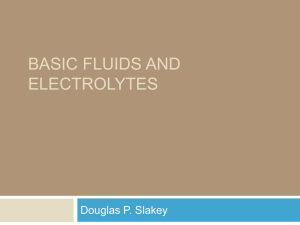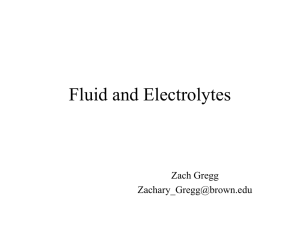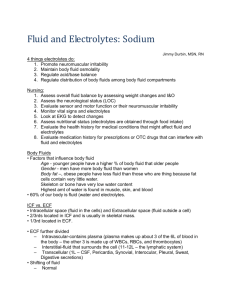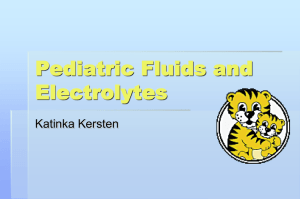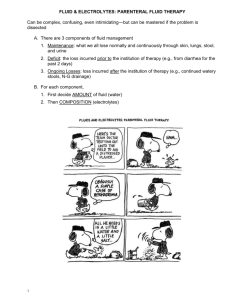ALL NEW FOR 2005(6)! Fluids and Electrolytes Made Simple
advertisement
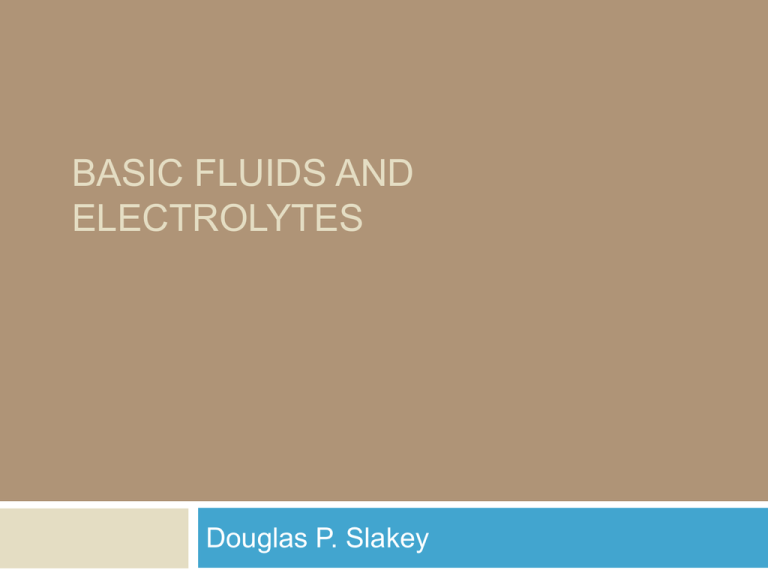
BASIC FLUIDS AND ELECTROLYTES Douglas P. Slakey Why ? Essential for surgeons (and all physicians) Based upon physiology Disturbances understood as pathophysiology To Encourage Thought Not Mechanical Reaction Most abnormalities are relatively simple, and many iatrogenic It's better to keep your mouth shut and let people THINK you're a fool than to open it and remove all doubt. Mark Twain It’s All About Balance Gains and Losses Losses Sensible and Insensible Typical adult, typical day Skin Lungs Kidneys Feces 600 ml 400 ml 1500 ml 100 ml Balance can be dramatically impacted by illness and medical care Fluid Compartments Total Body Water Relatively constant Depends upon fat content and varies with age Men 60% (neonate 80%, 70 year old 45%) Women 50% TOTAL BODY WATER 60% BODY WEIGHT ECF ICF 2/3 H2O 1/3 Predominant solute Predominant solute K+ Na+ I Love Salt Water! Electrolytes (mEq/L) Na 140 K Ca 5 Mg 2 Cl 103 HCO3 Protein Plasma Intracellular 12 4 24 16 150 0.0000001 7 3 10 40 Fluid Movement Is a continuous process Diffusion Solutes move from high to low concentration Osmosis Fluid moves from low to high solute concentration. Active Transport Solutes kept in high concentration compartment Requires ATP Movement of Water Osmotic activity Most important factor Determined by concentration of solutes Plasma (mOsm/L) 2 X Na + Glc + BUN 18 2.8 Third Space Abnormal shifts of fluid into tissues Not readily exchangeable Etiologies Tissue trauma Burns Sepsis Fluid Status Blood pressure Check for orthostatic changes Physical exam Invasive monitoring Arterial line CVP PA catheter Foley Remember JVD? Dx of Fluid Imbalances Must assess organ function Renal failure Heart failure Respiratory failure • • • Excessive GI fluid losses Burns Labs: electrolytes, osmolality, fractional excretion of Na, pH, Disorders to be able to diagnose AND Treat Volume deficit Volume excess Hyper/hypo –natremia Hyper/hypo –kalemia Hyper/hypo -calcemia Volume Deficit Most common surgical disorder Signs and symptoms CNS: sleepiness, apathy, reflexes, coma GI: anorexia, N/V, ileus CV: orthostatic hypotension, tachycardia with peripheral pulses Skin: turgor Metabolic: temperature Dehydration Chronic Volume Depletion Affects all fluid components Solutes become concentrated Increased osmolarity Hct can increase 6-8 pts for 1 L deficit Patients at risk: Cannot respond to thirst stimuli Diabetes insipidus Treatment: typically low Na fluids Hypovolemia Acute Volume Depletion Isotonic fluid loss, from extracellular compartment Determine etiology Hemorrhage, NG, fistulas, aggressive diuretic therapy Third space shifting, burns, crush injuries, ascites Replace with blood/isotonic fluid » Appropriate monitoring » Physical Exam » » Foley (u/o > 0.5 ml/kg/min) Hemodynamic monitoring Fluid Replacement Isotonic/physiologic NS (154 meq, 9 grams NaCl/L) LR (130 Na, 109 Cl, 28 lactate, 4 K, 3 Ca) Less concentrated 0.45NS, 0.2NS Maintenance Hypertonic Na Fluid Replacement Plasma Expanders For special situations Will increase oncotic pressure If abnormal microvasculature, will extravasate into “third space” Then may take a long time to return to circulation Fluid Replacement Maintenance 4,2,1 “rule” Other losses (fistulas, NG, etc) Can measure volume and composition!!! Should be thoughtfully assessed and prescribed separately if pathologic (i.e. gastric: H, Na, Cl) Maintenance Fluid Daily Na requirement: 1 to 2 mEq/kg/day Daily K requirement: 0.5 to 1 mEq/kg/day AHA Recommended Na intake: 4 to 6 grams per day To Replace Ongoing Losses, NOT Preexisting Deficits Maintenance Fluids D5 0.45NS + 20 mEq KCl/L at 125 ml/hr How much Sodium is Enough??? » NS » 0.9% = 9 grams Na per liter » 0.45 NS = 4.5 grams per liter » 125 ml/hour = 3000 ml in 24 hours » 3 liters X 4.5 grams Na = 13.5 GRAMS Na! (If 0.2 NS: 3 liters X 2 grams Na = 6 grams Na) “BTW Dr Slakey, the sodium is 120” Hyponatremia Na loss True loss of Na Dilutional (water excess) Inadequate Na intake Classified by extracellular volume Hyovolemic (hyponatremia) Diuretics, renal, NG, burns Isotonic (hyponatremia) Liver failure, heart failure, excessive hypotonic IVF Hypervolemic (hyponatremia) Glucocorticoid deficiency, hypothyroidism SIADH Causes Surgical stress (physiologic) Cancers (pancreas, oat cell) CNS (trauma, stroke) Pulmonary (tumors, asthma, COPD) Medications Anticonvulsants, antineoplastics, antipsychotics, sedatives (morphine) SIADH Too much ADH Affects renal tubule permeability Increases water retention (ECF volume) Increased plasma volume, dilutional hyponatremia, decreases aldosterone Increased Na excretion (Ur Na >40mEq/L) Fluid shifts into cells Symptoms: thirst, dyspnea, vomiting, abdominal cramps, confusion, lethargy SIADH Treatment Fluid restriction Will not responded to fluid challenge! i.e. a “Bolus” will not work (distinguishes from pre-renal cause) Possibly diuretics Hypovolemia and Metabolic Abnormality Acidosis May result from decreased perfusion i.e decreased intravascular volume Alkalosis Complex physiologic response to more chronic volume depletion i.e. vomiting, NG suction, pyloric stenosis, diuretics Paradoxical Aciduria Hypochloremic Hypovolemia Na Na H Cl K Loop of Henle Hypernatremia Relatively too little H2O Free water loss (burns, fever) Diabetes insipidus (head trauma, surgery, infections, neoplasm) Dilute urine (Opposite of SIADH) Nephrogenic DI Kidney cannot respond to ADH Hypernatremia Hypovolemic GI loss, osmotic diuresis Increased Na load (usually iatrogenic) Free water deficit: [0.6 X wt (kg)] X [Serum Na/140 - 1] Hypernatremia Volume Replacement Example: Na 153, 75 kg person (0.6 X 75) X [(153/140) - 1] 45 X [1.093 -1] 45 X 0.093 = 4.2 Liters Potassium and Ph Normally 98% intracellular Acidosis Extracellular H+ increases, H+ moves intracellular, forcing K+ extracellular Alkalosis Intracellular H+ decreases, K+ moves into cells (to keep intracellular fluid neutral) Hyperkalemia Associated medications Too much K+, ACE inhibitors, beta-blockers, antibiotics, chemotherapy, NSAIDS, spironolactone Treatment Mild: dietary restriction, assess medications Moderate: Kayexalate Do NOT use sorbitol enema in renal failure patients Severe: dialysis Hyperkalemia Emergency (> 6 mEq/l) Treatment Monitor ECG, VS Calcium gluconate IV (arrhythmias) Insulin and glucose IV Kayexalate, Lasix + IVF, dialysis The End Makani U’i
